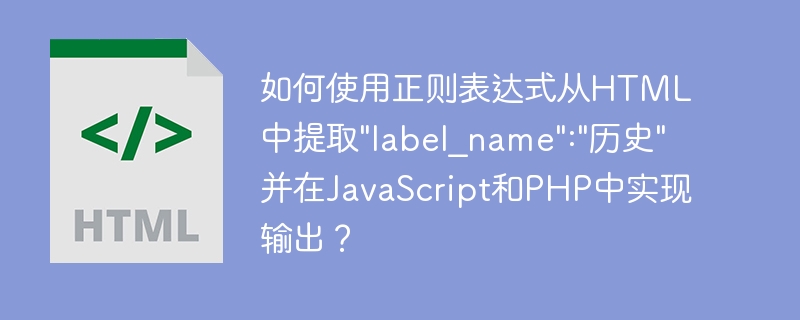 Web Front-end
Web Front-end
 HTML Tutorial
HTML Tutorial
 How to extract 'label_name' from HTML using regular expressions and implement output in JavaScript and PHP?
How to extract 'label_name' from HTML using regular expressions and implement output in JavaScript and PHP?
How to extract 'label_name' from HTML using regular expressions and implement output in JavaScript and PHP?

Efficiently extract HTML data: Detailed explanation of regular expression application
Extracting specific information from lengthy HTML code is a common task in web page data processing. This article will explain in detail how to use regular expressions to accurately extract target content in HTML, and provide JavaScript and PHP code examples to solve the problem of extracting "label_name":"历史" from the specified URL (where "history" is a variable).
Regular expression extracts target fields
Assuming that the HTML snippet contains "label_name":"历史" we can efficiently extract the field with regular expressions. The following JavaScript code demonstrates how to implement it:
const str = 'shflehoshofwe"label_name":"History"lshdliflwefoiewoilfjnwo';
const regex = /"label_name":"(. ?)"/;
const match = str.match(regex);
if (match) {
const value = match[0];
console.log(value); // Output: "label_name":"History"
} else {
console.log("No match found");
} Regular expression /"label_name":"(. ?)"/ matches the contents after "label_name":" , (. ?) uses non-greedy matching ( ? ), ensuring that only contents between the next double quotes are extracted.
PHP code to implement web page data extraction
If you need to get HTML content from the specified URL and then extract it, you can use PHP code:
$url = 'Specified URL';
$html = file_get_contents($url);
preg_match('/"label_name":"(. ?)"/', $html, $match);
if ($match) {
echo $match[0]; // Output: "label_name":"History"
} else {
echo "No match found";
} This code first uses file_get_contents() to get the HTML content of the specified URL, and then uses preg_match() function to perform regular expression matching and output the matched result.
Summarize
Through the above JavaScript and PHP code examples, we can easily extract target fields such as "label_name":"历史" from HTML, and can be extracted accurately even if the "History" part is dynamically changed. Remember, in practice, adjust regular expressions according to the specific HTML structure to ensure the accuracy of the extraction. Furthermore, for complex HTML structures, it is recommended to use a more powerful HTML parser instead of relying solely on regular expressions.
The above is the detailed content of How to extract 'label_name' from HTML using regular expressions and implement output in JavaScript and PHP?. For more information, please follow other related articles on the PHP Chinese website!

Hot AI Tools

Undresser.AI Undress
AI-powered app for creating realistic nude photos

AI Clothes Remover
Online AI tool for removing clothes from photos.

Undress AI Tool
Undress images for free

Clothoff.io
AI clothes remover

AI Hentai Generator
Generate AI Hentai for free.

Hot Article

Hot Tools

Notepad++7.3.1
Easy-to-use and free code editor

SublimeText3 Chinese version
Chinese version, very easy to use

Zend Studio 13.0.1
Powerful PHP integrated development environment

Dreamweaver CS6
Visual web development tools

SublimeText3 Mac version
God-level code editing software (SublimeText3)

Hot Topics
 1377
1377
 52
52
 What is the purpose of the <progress> element?
Mar 21, 2025 pm 12:34 PM
What is the purpose of the <progress> element?
Mar 21, 2025 pm 12:34 PM
The article discusses the HTML <progress> element, its purpose, styling, and differences from the <meter> element. The main focus is on using <progress> for task completion and <meter> for stati
 What is the purpose of the <datalist> element?
Mar 21, 2025 pm 12:33 PM
What is the purpose of the <datalist> element?
Mar 21, 2025 pm 12:33 PM
The article discusses the HTML <datalist> element, which enhances forms by providing autocomplete suggestions, improving user experience and reducing errors.Character count: 159
 What is the purpose of the <meter> element?
Mar 21, 2025 pm 12:35 PM
What is the purpose of the <meter> element?
Mar 21, 2025 pm 12:35 PM
The article discusses the HTML <meter> element, used for displaying scalar or fractional values within a range, and its common applications in web development. It differentiates <meter> from <progress> and ex
 What are the best practices for cross-browser compatibility in HTML5?
Mar 17, 2025 pm 12:20 PM
What are the best practices for cross-browser compatibility in HTML5?
Mar 17, 2025 pm 12:20 PM
Article discusses best practices for ensuring HTML5 cross-browser compatibility, focusing on feature detection, progressive enhancement, and testing methods.
 How do I use HTML5 form validation attributes to validate user input?
Mar 17, 2025 pm 12:27 PM
How do I use HTML5 form validation attributes to validate user input?
Mar 17, 2025 pm 12:27 PM
The article discusses using HTML5 form validation attributes like required, pattern, min, max, and length limits to validate user input directly in the browser.
 What is the viewport meta tag? Why is it important for responsive design?
Mar 20, 2025 pm 05:56 PM
What is the viewport meta tag? Why is it important for responsive design?
Mar 20, 2025 pm 05:56 PM
The article discusses the viewport meta tag, essential for responsive web design on mobile devices. It explains how proper use ensures optimal content scaling and user interaction, while misuse can lead to design and accessibility issues.
 What is the purpose of the <iframe> tag? What are the security considerations when using it?
Mar 20, 2025 pm 06:05 PM
What is the purpose of the <iframe> tag? What are the security considerations when using it?
Mar 20, 2025 pm 06:05 PM
The article discusses the <iframe> tag's purpose in embedding external content into webpages, its common uses, security risks, and alternatives like object tags and APIs.
 Gitee Pages static website deployment failed: How to troubleshoot and resolve single file 404 errors?
Apr 04, 2025 pm 11:54 PM
Gitee Pages static website deployment failed: How to troubleshoot and resolve single file 404 errors?
Apr 04, 2025 pm 11:54 PM
GiteePages static website deployment failed: 404 error troubleshooting and resolution when using Gitee...



